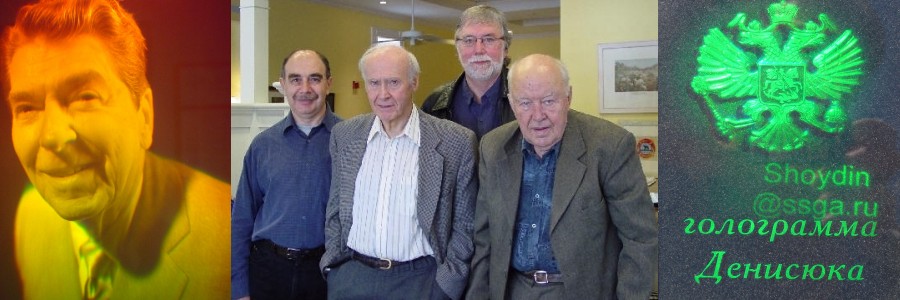Heroes of Holography
In the early 1960's a series of publications reported the discovery and potential applications of holographic interferometry. They became known as the Powell and Stetson papers. Robert H. Powell passed away in July, 2015. I asked Karl Stetson to reflect on his memories of his research partner. The following is Karl's response.
Memories of Robert L. Powell by Karl Stetson
I learned that today, July 21, 2015, Robert L. Powell died this morning at the age of 91 in a Houston Texas hospital from complications of prostate cancer. I spoke with his son, Robert Powell Jr. in response to an email I had received. What I would like to do here is to write down my memories of him, first as a professor, then as a friend, then as also a colleague.
I first met him when I was an undergraduate at what is now the University of Massachusetts at Lowell. Bob was one of the most competent and conscientious professors I had. If any of us asked a knotty question he couldn’t answer on the spot, we could be sure he would have the answer for us at our next class. We kept in contact after I graduated, and I remember my wife Elaine and I visiting him and his wife Betty 1962 when we were living near Buffalo, NY, and he had joined IBM at Owego, NY. In September, 1962, I moved to Ann Arbor, Michigan, and joined what was then the University of Michigan’s Institute of Science and Technology, (IST). I remember visiting him and describing the optical Fourier processing work that was being done at the IST. When I said the light had to be coherent, that precipitated an argument that lasted till the small hours of the night.
In 1964, Bob decided to leave IBM and was looking for another situation. Based on my enthusiasm for what we were doing, he interviewed at IST and was hired. Our main work at IST was airborne side-looking synthetic aperture radar; however, an offshoot was the off-axis hologram, something greatly aided by our recent acquisition of He-Ne lasers. By 1964, holograms had progressed from continuous tone transparencies, to diffusely illuminated transparencies, to three-dimensional objects. Bob and I were put to work to solve the “problem of the holograms,” i.e., that the brightest one yet made was a fluke that couldn’t be duplicated. We solved this problem, and in the process discovered holographic interferometry.
We didn’t know that, months earlier, Emmett Leith and Juris Upatnieks had observed results in hologram reconstructions that, in retrospect, were examples of holographic interferometry. They never sought to understand these phenomena, but when Powell and I made analogous observations, we proposed that separate recordings within a single hologram could give rise to interference between their reconstructions. We then did experiments that confirmed this, and went on to explore holography of vibrating objects. We were also the first to conceive and demonstrate that a hologram could act as a beamsplitter between the light reflected by an object and light reconstructed by its reference beam, the basis of real-time holographic interferometry.
It is fair to say that I was the primary experimentalist of our collaboration and that Bob was the main theoretician, but he was much more than that. He had a strong distrust of what was conventional wisdom around the laboratory, and he also had a keen understanding of the concepts of physics. When our observations suggested light beams that were incoherent during the recording of a hologram became coherent within its reconstruction, he recognized this was a ground-breaking discovery. Neither Powell nor I could have discovered holographic interferometry alone – it was the fortunate result of our combined capabilities.
In the winter of 1965, I left IST to join GCA Corporation in Massachusetts. By summer of 1966, Bob had left IST and was working for Grant/Crafton Optronics, GCO. In the fall of 1966, I left to join the Institute of Optical Research at the Royal Institute of Technology (KTH) in Stockholm to obtain my doctoral degree. Bob eventually left GCO and joined American Optical in Southbridge, Mass. We met, he and his wife Betty and I and my wife Elaine, in the summer of 1968 at a pair of conferences in Glasgow, Scotland, and Florence, Italy. He and I presented invited papers at the Glasgow conference.
I had contact with Bob in 1970 while I was at the National Physical Laboratory in England. He had started his own company, and we corresponded about that and legal issues that had arisen regarding the University of Michigan patents on holographic interferometry. I also had contact with him when he was at Oakland University in Rochester, Michigan, and I was at Ford Research Laboratories around 1972. I know he worked with Joseph Hovanesian there on photo-elastic effects in holographic interferometry. After that, I moved back to the East Coast and he moved back to Texas.
During the last forty years, we never met, but occasionally conversed by telephone and eventually by email. I know that in recent years he became very interested in Euclidean geometry and related material concerning subjects as diverse as fractals. At one point he sent me a draft of work on this subject, but, as I emailed him, for me it was like joining a book discussion group where not only had I not read the book, I didn’t even know what the book was. His was a unique mind, capable of remarkable insights and unique perspectives, and I will always be in his debt for launching me on what became my career.

